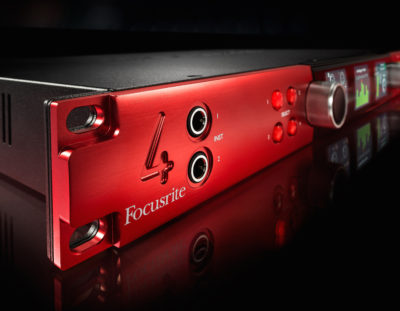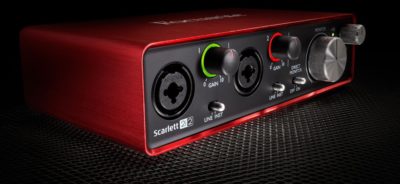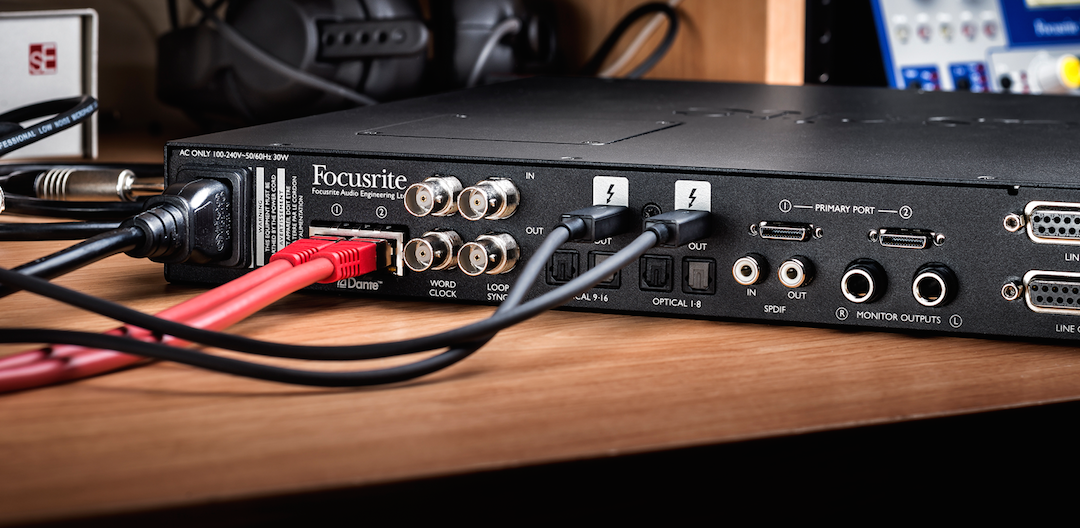New Gear Review: Focusrite’s Red 4Pre and the Second Generation of Scarlett
Focusrite is a brand that many audio pros know and trust, specializing in interfaces and mic pres for a broad range of budgets.
When the brand expanded from its roots in the 1980s, it started at the top end of the market with the Red series, before widening into the pro-sumer market in the 2000s. Today, they offer a diversity of interfaces at nearly every price point, plus their top-line ISA series of preamps.
The original high-end Red line of rackmount gear has been out of production for some time, but in recent years, the attitude of that classic line has re-emerged, first with the their RedNet system, and now with the Red 4Pre, released earlier this year.
The Red 4Pre could be considered Focusrite’s flagship DAW interface, sporting multiple input options and interconnectivity, four built-in preamps, and top-shelf AD/DA converters on board.
At the other end of the market, Focusrite has recently debuted the second generation of its low-priced Scarlett 2i2, which they have called the “world’s best selling interface”. The Scarlett retails at around $140, the Red 4Pre at around $2750.
Because I have used the original Red 1 pres for many years—they were arguably the “Rolls Royce” of mic pres back in the 1980s, offering stunning transient detail and warmth—I was curious as to how the Red 4Pre would compare against this heritage classic. And, how much better would the Red 4Pre be than the Scarlett?
This type of comparison raises questions about what is more important regarding recording quality: Is it the gain, the tone, the noise floor, or indeed the practical side of using the device?
I tested both interfaces into a 2012 Macbook Pro running Logic. Scarlett connects via USB, the Red 4Pre via Thunderbolt. Happily, both were recognized immediately, although I did have to launch the Focusrite Control software before the Red 4Pre levels made it into Logic. (I was able to close the app after launching and the interface continued to perform fine).
Latency
One of Focusrite’s claims is that their interfaces are among the very fastest, sporting some of the smallest latency measurements on the market.
Latency, the delay in converting the audio from analog to digital and back again, is a critical measurement for us to get under 10ms because by 12-15ms you will begin to discern a separation between the acoustic sound source and its reproduced version.
While it’s true that it won’t sound like two different signals until we hit latency of around 30ms, you may find that the effect is still a bit uncomfortable long before you hit that level.
Using the new second generation Scarlett 2i2, I set the buffer in Logic to 32 samples with a sample rate of 48k, giving me a roundtrip latency of just 6.5ms, which is not discernible at all.
At the same settings but now via Thunderbolt 2, the Red 4Pre gives an impressively low 2.7ms roundtrip latency. At 96k the latency is even lower. With these interfaces, recording native while using effects in real time is a pleasant reality, rather than a laggy nightmare.
Settings
You don’t have to use the included Focusrite Control software to enjoy these interfaces, but it does add considerably to the feature set.
Because the Red 4Pre has so many options to tweak, you may find it easier to use Focusrite Control to engage the +48v, phase, AIR and more, without ever getting up to use the front panel.
The gain controls, routing and settings are all digitally controlled on the Red4Pre and are therefore savable and recallable. Inputs 1-2 and 3-4 are linkable as well, making for better stereo matching than your fingers can easily provide.
Digital control also means that each time you change an option—such as turning on +48v or reversing the phase—the audio is silenced, which will save blowing a set of monitors or two, I’m sure.
Connections
The Scarlett and Red 4Pre both have Mic, Line and a recently optimized Instrument input. Both feature stereo line outs and a headphone jack on the front panel, with 2 headphone outs for the Red 4Pre.
The Red 4Pre offers Dante interconnectivity via its Ethernet port, meaning it could easily become part of a Focusrite Rednet expansion system. The addition of two Avid DigiLink™ connectors on the back means also that the Red 4Pre could offer very cost effective Dante expansion to a HDX system.
With 2 ADAT ports, SPDIF, Dante, and the analog D-Sub 25 pin connections, this unit offers 58 inputs and 64 outputs for your system, all in all.
Preamps and Converters
The gain range is 63dB on the Red 4Pre, while on the Scarlett series is a more modest 50dB. That means some older ribbon mics may be more of a challenge for the Scarlett.
The Scarlett offers a green LED around the pre pot to indicate the gain, which turns red on clipping, and is easy to see at a distance. Both of these interfaces comfortably amplified the mics I tried—a Shure SM57, Neumann U87, Rode NT2—with low (read inaudible) noise.
The Red4Pre boasts a new development in this area: Even lower noise at the A/D stage using two converters wired in parallel to give higher summed level.
This “parallel path conversion” is an ingenious feature that gives an additional increase in signal level of 6dB (because the two signals are in phase) while random noise is only increased by 3dB thanks to phase cancellation of the noise. The result: A net improvement of signal/noise ratio of 3dB.
For high-resolution enthusiasts the Red 4Pre has a frequency response of +/-0.2 dB 20Hz – 35kHz whereas the Scarlett offers this kind of performance at a more typical 20-20kHz. (The Red 4Pre offers a frequency response of +/-0.1dB from 20 Hz-20 kHz.)
I decided that recording an acoustic guitar using the Neumann U87 would be a good test of transient response and tone. I also arranged a couple of further options: I borrowed a first generation Scarlett 2i4, and also ran a recording through an original Red 1 pre into the Scarlett 2i2 interface. (Apologies in advance for the playing!)
No EQ or compression has been applied, and I’ve done a quick level match on each. Click here to hear them.
Results
The Red 4Pre offered a lovely, rich tone and was the clear winner out of all four options. The lower mids and frequencies in the 50-100Hz region are solid and differentiated, the top end is open and transparent sounding, and the overall feel is gentle and natural.
Compared to the Red 1 pre, which also shares this characteristic “open” top end, the Red 4Pre has slightly less warmth, and more clarity and top end air. The Red 1 also feels subtly tighter in the bottom end.
The “openness” is the likely result of the high linearity of the transformer used in the Red series. With the AIR function engaged, the result is a brighter tone, and frankly, a bit more like adding a subtle high EQ shelf.
This function, according to Focusrite, creates something similar to the “transformer resonance effect”, giving the air and clarity of an ISA transformer-based mic pre. I didn’t find it to be too overpowering, although I would probably leave it off if recording potentially sibilant vocals or spoken word.
Comparing the recordings made by the Red 4Pre the entire frequency range is more detailed than heard via the Scarlett, although the second generation Scarlett has a slight edge on the first generation 2i4.
The 2i2 tone is pleasant and consistent throughout the frequency range, and there is no shrill top end or plastic-y midrange on any of the Scarlett interfaces. They just lack some of that irresistible sweetness found in the Red series.
Though the tone on the Scarlett recordings may lack the sweet character of the Reds, the sound is indeed flat, and it’s a great starting point for applying further EQ if needed.
I did an additional headroom test on the Red4Pre, which boasts maximum mic input levels of +19dBu, compared to the Scarlett’s +4 max. I did some very loud claps in front of the mic to see if I could get it to clip in an unpleasant sounding manner, and I just couldn’t, which is a lifesaver when you are under pressure in a multi-channel recording situation.
I’m sure no one will be surprised that there is a significant difference in the quality of these two interfaces. The Red 4Pre inherits the clean and silky mic qualities of the ISA series and the Red 1. Its converters are super clean and fast, and it offers a significant set of extras in the way of connectivity, bringing it all together in a compact 1U rack unit.
But, let’s also hear it for the Scarlett range: Simple to set up, amazingly low latency, with a very nice flat tone and a tiny footprint considering the quality.
Check out the audio files here. It’s worth listening to each a few times, as the differences are subtle to start, with the edge that the Red 4Pre has becoming increasingly obvious the more you take the time to listen.
Please note: When you buy products through links on this page, we may earn an affiliate commission.









